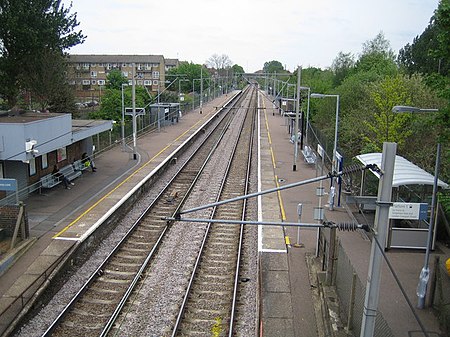Ponders End railway station
DfT Category C2 stationsEnfield, LondonFormer Great Eastern Railway stationsGreater Anglia franchise railway stationsLondon stations without latest usage statistics 1415 ... and 5 more
London stations without latest usage statistics 1516Rail transport stations in London fare zone 5Railway stations in Great Britain opened in 1840Railway stations in the London Borough of EnfieldUse British English from August 2012

Ponders End railway station is on the West Anglia Main Line, serving the district of Ponders End in the London Borough of Enfield, north London. It is 9 miles 71 chains (15.9 km) down the line from London Liverpool Street and is located between Meridian Water and Brimsdown. Its three-letter station code is PON and it is in Travelcard zone 5. The station and all trains serving it are operated by Greater Anglia. It is near to Lee Valley Leisure Complex.
Excerpt from the Wikipedia article Ponders End railway station (License: CC BY-SA 3.0, Authors, Images).Ponders End railway station
Meridian Way, London Ponders End (London Borough of Enfield)
Geographical coordinates (GPS) Address Nearby Places Show on map
Geographical coordinates (GPS)
| Latitude | Longitude |
|---|---|
| N 51.6421 ° | E -0.03518 ° |
Address
Ponders End Platform 1
Meridian Way
EN3 4QB London, Ponders End (London Borough of Enfield)
England, United Kingdom
Open on Google Maps







